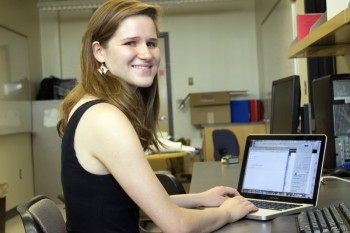Summer Centered: Cora Hersh '16 Seeing the Light in Dark Matter

Cora Hersh '16
Photo by Hina Fathima '15
Details
Cora Hersh '16 is working for Assistant Professor of Physics Kerstin Perez using data from an x-ray satellite telescope called NuSTAR.
Cora Hersh '16 is spending her summer gazing into the depths of space in hopes of learning more about dark matter while working for Assistant Professor of Physics Kerstin Perez. "Some theories about dark matter particles, especially axions and sterile neutrinos, say that dark matter can decay into photons, which can then be detected by a telescope," says Hersh. "Eventually, I will be using data from an x-ray satellite telescope called NuSTAR to look at objects in the universe where dark matter is present in high concentrations." If her data reveals small peaks in light, it will confirm these theories. If not, it will suggest that dark matter does not decay into photons.
The work Hersh is doing for Perez is unlike anything she has done to date and involves particle physics, astronomy, and programming. This research is on the cutting edge of the scientific community's understanding of dark matter. "NuSTAR is the first focusing telescope in the energy range it observes, which means that it has a much better energy resolution than any previous projects that looked at high-energy x-rays," says Hersh. "This is why we have a chance of seeing something that nobody has observed before."
"I like that I have the opportunity to do research that is so current," she says. "A lot of the articles I'm reading for background information were only published in the last few years. It's such a different experience from being in a classroom and learning about things that have already been figured out."
Before arriving at Haverford, Hersh wasn't sure what to major in, but she quickly settled on physics her first year here. "The physics and astronomy department at Haverford is tight-knit," says Hersh. "[W]e have annual picnics and holiday parties complete with physics-themed sing-alongs, but [the department is] also full of incredibly smart people who constantly inspire [and] intimidate me. I always figured that even if the going got tough, at least I would like the people I was working with."
Most of Hersh's KINSC-sponsored summer will be spent writing a proposal for NuSTAR to make specific observations. She will then learn how to interpret the data she receives, which will prove important as Hersh continues this work next year as a part of her senior thesis in physics.
—Jack Hasler '15
"Summer Centered" is a series exploring our students' Center-funded summer work.



